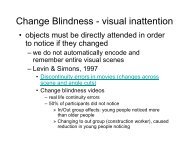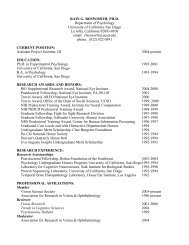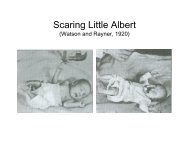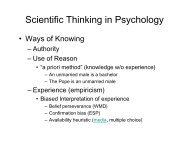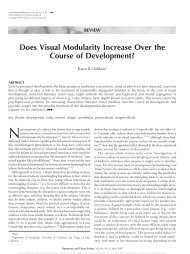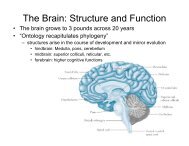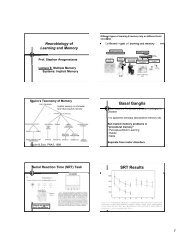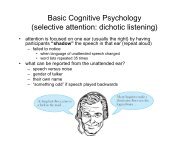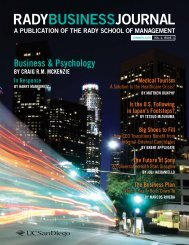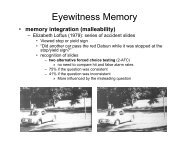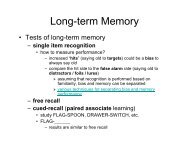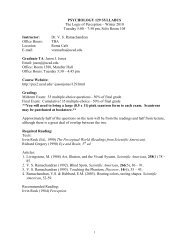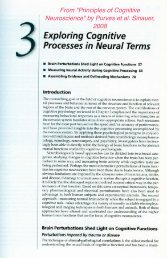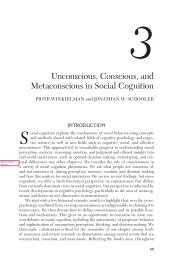For Peer Review Only - Establishing New Traditions
For Peer Review Only - Establishing New Traditions
For Peer Review Only - Establishing New Traditions
Create successful ePaper yourself
Turn your PDF publications into a flip-book with our unique Google optimized e-Paper software.
<strong>For</strong> <strong>Peer</strong> <strong>Review</strong> <strong>Only</strong><br />
Colored halos around faces and emotion-evoked colors: a<br />
new form of synesthesia<br />
Journal: Neurocase<br />
Manuscript ID: NCS-OA 10-136.R2<br />
Manuscript Type: Original Article<br />
Date Submitted by the<br />
Author: 27-Apr-2011<br />
Neurocase<br />
Complete List of Authors: Ramachandran, Vilayanur S.; UCSD, Center for brain<br />
Miller, Luke; University of CA, San Diego<br />
Livingstone, Margaret; Harvard<br />
Brang, David; University of CA, San Diego<br />
Keywords: synaesthesia, color, fusiform, ffa, qualia, aura<br />
URL: http:/mc.manuscriptcentral.com/nncs Email: hbc@mail.med.upenn.edu
Page 1 of 22<br />
1<br />
2<br />
3<br />
4<br />
5<br />
6<br />
7<br />
8<br />
9<br />
10<br />
11<br />
12<br />
13<br />
14<br />
15<br />
16<br />
17<br />
18<br />
19<br />
20<br />
21<br />
22<br />
23<br />
24<br />
25<br />
26<br />
27<br />
28<br />
29<br />
30<br />
31<br />
32<br />
33<br />
34<br />
35<br />
36<br />
37<br />
38<br />
39<br />
40<br />
41<br />
42<br />
43<br />
44<br />
45<br />
46<br />
47<br />
48<br />
49<br />
50<br />
51<br />
52<br />
53<br />
54<br />
55<br />
56<br />
57<br />
58<br />
59<br />
60<br />
Colored halos around faces and emotion-evoked colors: a new form of synesthesia<br />
Running Title: Colored halos and emotion-evoked colors<br />
Vilayanur S. Ramachandran 1 , Luke Miller 1 , Margaret S. Livingstone 2 , David Brang 1<br />
1 University of CA, San Diego<br />
2 Harvard University<br />
Corresponding Author:<br />
VS Ramachandran<br />
<strong>For</strong> <strong>Peer</strong> <strong>Review</strong> <strong>Only</strong><br />
University of CA, San Diego<br />
9500 Gilman Dr 0109<br />
La Jolla, CA 92093-0109<br />
P. 858.534.7907<br />
F. 858.534.7190<br />
E. vramacha@ucsd.edu<br />
Word Count: 3214<br />
Neurocase<br />
Keywords: synaesthesia, color, fusiform, ffa, qualia<br />
URL: http:/mc.manuscriptcentral.com/nncs Email: hbc@mail.med.upenn.edu<br />
1
1<br />
2<br />
3<br />
4<br />
5<br />
6<br />
7<br />
8<br />
9<br />
10<br />
11<br />
12<br />
13<br />
14<br />
15<br />
16<br />
17<br />
18<br />
19<br />
20<br />
21<br />
22<br />
23<br />
24<br />
25<br />
26<br />
27<br />
28<br />
29<br />
30<br />
31<br />
32<br />
33<br />
34<br />
35<br />
36<br />
37<br />
38<br />
39<br />
40<br />
41<br />
42<br />
43<br />
44<br />
45<br />
46<br />
47<br />
48<br />
49<br />
50<br />
51<br />
52<br />
53<br />
54<br />
55<br />
56<br />
57<br />
58<br />
59<br />
60<br />
Abstract<br />
Neurocase<br />
The claim that some individuals see colored halos or auras around faces has long been part of<br />
popular folklore. Here we report on a 23 year-old man (subject TK) diagnosed with Asperger’s<br />
Disorder, who began to consistently experience colors around individuals at the age of 10. TK’s<br />
<strong>For</strong> <strong>Peer</strong> <strong>Review</strong> <strong>Only</strong><br />
colors are based on the individual’s identity and emotional connotation. We interpret these<br />
experiences as a form of synesthesia, and confirm their authenticity through a target detection<br />
paradigm. Additionally, we investigate TK’s claim that emotions evoke highly specific colors,<br />
allowing him, despite his Asperger’s, to introspect on emotions and recognize them in others.<br />
URL: http:/mc.manuscriptcentral.com/nncs Email: hbc@mail.med.upenn.edu<br />
2<br />
Page 2 of 22
Page 3 of 22<br />
1<br />
2<br />
3<br />
4<br />
5<br />
6<br />
7<br />
8<br />
9<br />
10<br />
11<br />
12<br />
13<br />
14<br />
15<br />
16<br />
17<br />
18<br />
19<br />
20<br />
21<br />
22<br />
23<br />
24<br />
25<br />
26<br />
27<br />
28<br />
29<br />
30<br />
31<br />
32<br />
33<br />
34<br />
35<br />
36<br />
37<br />
38<br />
39<br />
40<br />
41<br />
42<br />
43<br />
44<br />
45<br />
46<br />
47<br />
48<br />
49<br />
50<br />
51<br />
52<br />
53<br />
54<br />
55<br />
56<br />
57<br />
58<br />
59<br />
60<br />
Introduction<br />
Neurocase<br />
In the 19 th century, Francis Galton observed that a certain proportion of the general<br />
population who were otherwise normal had a condition he dubbed “synesthesia”; a sensory<br />
stimulus presented through one modality spontaneously evoked a sensation in an unrelated<br />
<strong>For</strong> <strong>Peer</strong> <strong>Review</strong> <strong>Only</strong><br />
modality (Galton, 1883). <strong>For</strong> example, an individual may experience a specific color for every<br />
given note, or every grapheme (printed number or letter) may be tinged with a specific hue (e.g.<br />
C-sharp or the number 5 evoking red). Although synesthetic experiences were long disregarded<br />
as a rare curiosity, there has been a tremendous resurgence of interest in the last decade (e.g.<br />
Ramachandran & Hubbard, 2001a; Ramachandran & Hubbard, 2003a; Mattingley, Rich,<br />
Yelland, Bradshaw, 2001). Furthermore, this research has demonstrated that the phenomenon is<br />
relatively common (2-4% of the population; Simner et al., 2006), is mediated by genetic factors<br />
(Asher et al., 2009), and can influence aspects of everyday life ranging from memory (Smilek,<br />
Dixon, Cudahy, Merikle, 2002) to creativity (Ward, Thompson-Lake, Ely, Kaminski, 2008).<br />
Several lines of evidence suggest that in most instances of synesthesia, the evoked color<br />
is a sensory experience as opposed to a high-level memory association (e.g. from having used<br />
colored refrigerator magnets as a child). Synesthetically induced colors can lead to perceptual<br />
segregation (Ramachandran & Hubbard, 2001a; Ward, Jonas, Dienes, Seth, 2010), different<br />
portions of a single letter can have multiple colors (Ramachandran & Brang, 2010), and some<br />
color anomalous synesthetes may even see synesthetic colors that are unique from those<br />
experienced in the real world (Martian colors; Ramachandran & Hubbard, 2001b), despite the<br />
absence of the “necessary” cone pigments. Furthermore, synesthetically induced colors can drive<br />
apparent motion (Ramachandran & Azoulai, 2006; Kim, Blake, Palmeri, 2006) and the vividness<br />
of synesthetic colors can vary with eccentricity and field laterality (Brang & Ramachandran,<br />
URL: http:/mc.manuscriptcentral.com/nncs Email: hbc@mail.med.upenn.edu<br />
3
1<br />
2<br />
3<br />
4<br />
5<br />
6<br />
7<br />
8<br />
9<br />
10<br />
11<br />
12<br />
13<br />
14<br />
15<br />
16<br />
17<br />
18<br />
19<br />
20<br />
21<br />
22<br />
23<br />
24<br />
25<br />
26<br />
27<br />
28<br />
29<br />
30<br />
31<br />
32<br />
33<br />
34<br />
35<br />
36<br />
37<br />
38<br />
39<br />
40<br />
41<br />
42<br />
43<br />
44<br />
45<br />
46<br />
47<br />
48<br />
49<br />
50<br />
51<br />
52<br />
53<br />
54<br />
55<br />
56<br />
57<br />
58<br />
59<br />
60<br />
2009). Taken collectively, these observations support the early sensory cross-activation theory of<br />
synesthesia, although these do not negate powerful top-down influences (demonstrated using<br />
Navon figures; Ramachandran & Hubbard, 2001b) and the existence of higher forms of<br />
synesthesia that are more “conceptually driven” and harder to relate to physiology.<br />
<strong>For</strong> <strong>Peer</strong> <strong>Review</strong> <strong>Only</strong><br />
Research into the neural basis of synesthesia has further confirmed the sensory cross-<br />
activation theory of many robust forms of synesthesia. <strong>For</strong> example, simple achromatic<br />
graphemes will spontaneously and inevitably activate grapheme-regions in the fusiform gyrus in<br />
tandem with area V4 (Hubbard, Arman, Ramachandran, Boynton, 2005; Sperling et al., 2006;<br />
Brang et al., 2010). Furthermore, the cross-activation of these sensory regions is mediated by<br />
increased white-matter connectivity in synesthetes, as assessed by diffusion tensor imaging<br />
(Rouw & Scholte, 2007). Given that the fusiform gyrus has clusters of cells responsive to faces<br />
in addition to colors and graphemes, one might predict the existence of "face-color" synesthesia<br />
in some individuals. Further, such incidences of which may explain the occasional reports of<br />
colored halos around individuals – a phenomenon that is usually relegated to the domain of<br />
fringe psychology. We had searched for such synesthetes over a decade ago, to no avail, but<br />
recently came across one by accident.<br />
Case Report<br />
Neurocase<br />
TK is a 23 year-old male who had been clinically diagnosed with Asperger’s syndrome.<br />
According to TK, when he was younger he found it impossible to understand facial expressions<br />
and emotions, whether his own or those of others, and thus found it difficult to interact socially.<br />
Around the age of 10 his mother suggested that he attempt to label the feeling of each emotion<br />
(presumably based on context, social situation and facial expressions) with a specific color, in an<br />
URL: http:/mc.manuscriptcentral.com/nncs Email: hbc@mail.med.upenn.edu<br />
4<br />
Page 4 of 22
Page 5 of 22<br />
1<br />
2<br />
3<br />
4<br />
5<br />
6<br />
7<br />
8<br />
9<br />
10<br />
11<br />
12<br />
13<br />
14<br />
15<br />
16<br />
17<br />
18<br />
19<br />
20<br />
21<br />
22<br />
23<br />
24<br />
25<br />
26<br />
27<br />
28<br />
29<br />
30<br />
31<br />
32<br />
33<br />
34<br />
35<br />
36<br />
37<br />
38<br />
39<br />
40<br />
41<br />
42<br />
43<br />
44<br />
45<br />
46<br />
47<br />
48<br />
49<br />
50<br />
51<br />
52<br />
53<br />
54<br />
55<br />
56<br />
57<br />
58<br />
59<br />
60<br />
attempt to relay the appropriate emotions to his father and her. <strong>For</strong> example, while experiencing<br />
what he considered happiness he would tell his parents that he was feeling “green”. It is unclear<br />
whether there were pre-existing emotion-color biases which were subsequently encouraged by<br />
his parents or whether they were arbitrarily imposed in early life by his parents to infuse in him<br />
<strong>For</strong> <strong>Peer</strong> <strong>Review</strong> <strong>Only</strong><br />
some semblance of an emotional life. In either case, he reports that this strategy helped<br />
immensely. Further, by comparing the color elicited by another person with the emotion that<br />
would be associated with the same color in his own mind, TK was able to "read" the other<br />
individuals' emotions more accurately.<br />
At about the same time that he began associating colors with emotions (Experiment 2), he<br />
also began seeing colored halos around individuals (Experiment 1). The color of these halos<br />
corresponds to TK’s emotional stance toward that particular person, and when a new individual<br />
is encountered a blue halo emerges de-nouveau and the color evolves progressively with<br />
repeated exposure. TK claims that the halos are clearly “seen” or perceived around the person’s<br />
face and body and not merely imagined (although such words lose their resolving power when<br />
dealing with such ineffable experiences as synesthesia).<br />
Experiment 1: TK’s Halos<br />
Neurocase<br />
During our initial interview, TK was accompanied by a female companion who he had<br />
known for several years. We instructed him to look at this individual standing in front of a blank<br />
white screen and TK noted that he perceived a bright red halo radiating approximately 4 to 6<br />
visual degrees from her body. We then drew an outline on the screen surrounding his companion<br />
(see Figure 1). TK noted with surprise that the colored halo became more intense, spread out<br />
from the body, and was blocked precisely and crisply at the outline; behaving in this regard like<br />
URL: http:/mc.manuscriptcentral.com/nncs Email: hbc@mail.med.upenn.edu<br />
5
1<br />
2<br />
3<br />
4<br />
5<br />
6<br />
7<br />
8<br />
9<br />
10<br />
11<br />
12<br />
13<br />
14<br />
15<br />
16<br />
17<br />
18<br />
19<br />
20<br />
21<br />
22<br />
23<br />
24<br />
25<br />
26<br />
27<br />
28<br />
29<br />
30<br />
31<br />
32<br />
33<br />
34<br />
35<br />
36<br />
37<br />
38<br />
39<br />
40<br />
41<br />
42<br />
43<br />
44<br />
45<br />
46<br />
47<br />
48<br />
49<br />
50<br />
51<br />
52<br />
53<br />
54<br />
55<br />
56<br />
57<br />
58<br />
59<br />
60<br />
some sensory color illusions such as “neon spreading” (Nakayama, Shimojo, Ramachandran,<br />
1990). When we made a small gap in the outline TK exclaimed that the color “leaked out”<br />
through the opening by a few inches. By drawing the outline selectively around the face, arms, or<br />
torso we were able to show that the color evoked was especially pronounced around the face and<br />
<strong>For</strong> <strong>Peer</strong> <strong>Review</strong> <strong>Only</strong><br />
less so around other body parts. This fits the physiological observation (Downing, Jiang,<br />
Shuman, Kanwisher, 2001) that although the fusiform gyrus also has cells for arms, they are<br />
sparser than those tuned to faces.<br />
After TK made the observation that a border drawn around a subject “traps” his halos, we<br />
performed some informal tests to determine the validity of his statement. We asked TK to look at<br />
the student’s face while we surreptitiously introduced a large vivid red spot near the student’s ear<br />
(approximately 2 degrees visual angle). The spot served as a vivid cue against the white<br />
background, being immediately noticed and attended to by the other researchers in the room. TK<br />
did not notice any change. Yet when we repeated the procedure with a green spot, TK<br />
spontaneously attended to the spot as expected, and queried us about it. After presenting the red<br />
spot a second time after delay, he again failed to notice it was there. It was only after TK was<br />
told that a spot was present and asked to identify its location that TK located it after several<br />
seconds of searching. The same pattern of results were not seen when a spot, red or green was<br />
introduced to a location outside of the border. Under these circumstances, TK spontaneously<br />
attended to them. This formed the basis for a formal reaction time experiment to give objective<br />
verification that TK does indeed experience halos.<br />
Methods<br />
Neurocase<br />
URL: http:/mc.manuscriptcentral.com/nncs Email: hbc@mail.med.upenn.edu<br />
6<br />
Page 6 of 22
Page 7 of 22<br />
1<br />
2<br />
3<br />
4<br />
5<br />
6<br />
7<br />
8<br />
9<br />
10<br />
11<br />
12<br />
13<br />
14<br />
15<br />
16<br />
17<br />
18<br />
19<br />
20<br />
21<br />
22<br />
23<br />
24<br />
25<br />
26<br />
27<br />
28<br />
29<br />
30<br />
31<br />
32<br />
33<br />
34<br />
35<br />
36<br />
37<br />
38<br />
39<br />
40<br />
41<br />
42<br />
43<br />
44<br />
45<br />
46<br />
47<br />
48<br />
49<br />
50<br />
51<br />
52<br />
53<br />
54<br />
55<br />
56<br />
57<br />
58<br />
59<br />
60<br />
A 1.6 meter tall female undergraduate (who had a blue halo) stood 15 centimeters away<br />
from the white sheet. The previously described images were back-projected onto the white sheet<br />
around the body of the female undergraduate (Figure 1). Each participant stood 1.5 meters away<br />
from the sheet as a single grapheme was projected at a random location either inside or outside<br />
<strong>For</strong> <strong>Peer</strong> <strong>Review</strong> <strong>Only</strong><br />
of the border. An early localizer task using black dots determined that each grapheme location<br />
was clearly visible by each subject, and TK indicated that his halo was trapped at each location<br />
along the border. Each subject was instructed to indicate whether the present grapheme was<br />
either an ‘A’ or an ‘M’, and did so by speaking into a microphone (accuracy recorded for offline<br />
processing and voice onset response times recorded by EPrime Serial Response Box). Each<br />
grapheme was presented without time limit, although subjects were told to respond as quickly<br />
and accurately as possible. Each response was followed by a 2250 millisecond break where only<br />
the border was present. A beep indicated the beginning of each trial and let the subject know to<br />
begin looking for the grapheme. There were five blocks; each containing 32 trials with randomly<br />
assigned graphemes and locations for a total of 160 trials for the whole experiment (40 for each<br />
grapheme; blue A, blue M, orange A, orange M). <strong>For</strong> each colored grapheme there were 20<br />
images per side (e.g. left), ten of which were located inside of the border. Each grapheme<br />
subtended 1.5 degrees visual angle vertically, and was a minimum of 3 degrees visual angle from<br />
the student’s body. Three-minute breaks were given between each block.<br />
Apparatus<br />
Neurocase<br />
------ Figure 1----<br />
A projector (Proxima Desktop Projetor 9260; Proxima Corp.; San Diego, CA) was used<br />
to backlight a 1.76 x 2.26 meter white sheet. The projector was 0.77 meters off the ground and<br />
URL: http:/mc.manuscriptcentral.com/nncs Email: hbc@mail.med.upenn.edu<br />
7
1<br />
2<br />
3<br />
4<br />
5<br />
6<br />
7<br />
8<br />
9<br />
10<br />
11<br />
12<br />
13<br />
14<br />
15<br />
16<br />
17<br />
18<br />
19<br />
20<br />
21<br />
22<br />
23<br />
24<br />
25<br />
26<br />
27<br />
28<br />
29<br />
30<br />
31<br />
32<br />
33<br />
34<br />
35<br />
36<br />
37<br />
38<br />
39<br />
40<br />
41<br />
42<br />
43<br />
44<br />
45<br />
46<br />
47<br />
48<br />
49<br />
50<br />
51<br />
52<br />
53<br />
54<br />
55<br />
56<br />
57<br />
58<br />
59<br />
60<br />
3.43 meters behind the white sheet. The projector was tiled 90° on its side in order to present the<br />
visual images vertically in an appropriate size.<br />
Results<br />
<strong>For</strong> <strong>Peer</strong> <strong>Review</strong> <strong>Only</strong><br />
Results revealed subject TK was slower to identify letters located inside the halo<br />
boundary that were congruously colored with his halo (2568.8 ms), compared to any of the<br />
control conditions (inside halo incongruous color, 1139.3 ms; outside halo congruous color,<br />
1056.2 ms; outside halo incongruous color, 1055.9 ms). This dissociation was confirmed with a 2<br />
x 2 x 10 ANOVA with factors of color congruity (Congruous/incongruous), location<br />
(inside/outside of the halo border), and target presentation (where along the subject’s body the<br />
target was presented) applied to TK’s response times for correctly locating targets revealed main<br />
effects of congruity [F(1, 138) = 131.0, p
Page 9 of 22<br />
1<br />
2<br />
3<br />
4<br />
5<br />
6<br />
7<br />
8<br />
9<br />
10<br />
11<br />
12<br />
13<br />
14<br />
15<br />
16<br />
17<br />
18<br />
19<br />
20<br />
21<br />
22<br />
23<br />
24<br />
25<br />
26<br />
27<br />
28<br />
29<br />
30<br />
31<br />
32<br />
33<br />
34<br />
35<br />
36<br />
37<br />
38<br />
39<br />
40<br />
41<br />
42<br />
43<br />
44<br />
45<br />
46<br />
47<br />
48<br />
49<br />
50<br />
51<br />
52<br />
53<br />
54<br />
55<br />
56<br />
57<br />
58<br />
59<br />
60<br />
color, 807.0 ms), yet revealed main effects of congruity at the group level [F(1,3) = 10.6, p
1<br />
2<br />
3<br />
4<br />
5<br />
6<br />
7<br />
8<br />
9<br />
10<br />
11<br />
12<br />
13<br />
14<br />
15<br />
16<br />
17<br />
18<br />
19<br />
20<br />
21<br />
22<br />
23<br />
24<br />
25<br />
26<br />
27<br />
28<br />
29<br />
30<br />
31<br />
32<br />
33<br />
34<br />
35<br />
36<br />
37<br />
38<br />
39<br />
40<br />
41<br />
42<br />
43<br />
44<br />
45<br />
46<br />
47<br />
48<br />
49<br />
50<br />
51<br />
52<br />
53<br />
54<br />
55<br />
56<br />
57<br />
58<br />
59<br />
60<br />
Experiment 2: Emotion-Color Synesthesia<br />
As part of TK’s phenomenological descriptions, he reported that when he experiences<br />
emotional states or views them in others he indiscriminately experiences a specific color paired<br />
with the appropriate emotion (e.g. pride is blue, and aggression red). In order to examine the<br />
<strong>For</strong> <strong>Peer</strong> <strong>Review</strong> <strong>Only</strong><br />
authenticity of TK’s emotion-color pairings, we tested the strength of these associations using<br />
modified and classic versions of the stroop interference task.<br />
Methods<br />
Subjects were instructed to read aloud the visual color of either a color word (2 blocks<br />
containing 24 trials each) or an emotional word (2 blocks containing, 24 trials each). The order<br />
of the blocks alternated between color word and emotional word. 50% of trials were congruous<br />
to the respective stimuli and 50% were incongruous; congruity of emotional word colors were<br />
based on TK's color associations. Trial orders were randomized. Colored stimuli were presented<br />
on a grey background (Arial, subtending 2 degrees visual angle vertically) until a vocal response<br />
was produced; vocal onset was registered using an EPrime SRBox response device.<br />
Results<br />
Neurocase<br />
Results from the emotional word condition are presented in Figure 3. TK’s mean<br />
response times for each condition differed as a function of congruity for both color words<br />
(congruous 742.7 ms; incongruous 1035.4 ms) as well as emotional words (congruous 1147.6<br />
ms; incongruous 1461.4 ms). Confirming differences between these conditions, a 2 x 2 ANOVA<br />
with factors of word type (color/emotional words) and congruity (congruous/incongruous)<br />
applied to TK's data revealed significant main effects of word type [F(1,86)=21.5, p
Page 11 of 22<br />
1<br />
2<br />
3<br />
4<br />
5<br />
6<br />
7<br />
8<br />
9<br />
10<br />
11<br />
12<br />
13<br />
14<br />
15<br />
16<br />
17<br />
18<br />
19<br />
20<br />
21<br />
22<br />
23<br />
24<br />
25<br />
26<br />
27<br />
28<br />
29<br />
30<br />
31<br />
32<br />
33<br />
34<br />
35<br />
36<br />
37<br />
38<br />
39<br />
40<br />
41<br />
42<br />
43<br />
44<br />
45<br />
46<br />
47<br />
48<br />
49<br />
50<br />
51<br />
52<br />
53<br />
54<br />
55<br />
56<br />
57<br />
58<br />
59<br />
60<br />
congruity [F(1,86)=11.1, p=.001] and critically showed no interaction between the two<br />
[F(1,86)=.002, p=.96]. Follow-up analyses using an unpaired t-test showed significant effects of<br />
congruity for both color words t(45)=3.49, p=.001, as well as emotional words t(41)=2.03, p=.05,<br />
confirming TK’s reports that emotional words are linked with the experience of color.<br />
<strong>For</strong> <strong>Peer</strong> <strong>Review</strong> <strong>Only</strong><br />
Non-synesthetic control subjects (n=15) tested on a matched procedure also showed main<br />
effects of word type [F(1,14)=12.5, p
1<br />
2<br />
3<br />
4<br />
5<br />
6<br />
7<br />
8<br />
9<br />
10<br />
11<br />
12<br />
13<br />
14<br />
15<br />
16<br />
17<br />
18<br />
19<br />
20<br />
21<br />
22<br />
23<br />
24<br />
25<br />
26<br />
27<br />
28<br />
29<br />
30<br />
31<br />
32<br />
33<br />
34<br />
35<br />
36<br />
37<br />
38<br />
39<br />
40<br />
41<br />
42<br />
43<br />
44<br />
45<br />
46<br />
47<br />
48<br />
49<br />
50<br />
51<br />
52<br />
53<br />
54<br />
55<br />
56<br />
57<br />
58<br />
59<br />
60<br />
The very idea of halos, colors emanating from an individual’s ‘energy field’, is usually<br />
met with utmost incredulity and skepticism by scientists; so much so that the renowned magician<br />
and arch-skeptic James Randi has offered a million dollar prize to anyone who can establish their<br />
existence. Here we provide the first evidence of the existence of this effect. We demonstrate not<br />
<strong>For</strong> <strong>Peer</strong> <strong>Review</strong> <strong>Only</strong><br />
only the authenticity of the phenomenon (that it isn’t made up by the subject) but that colors<br />
evoked are perceptually “real’ in the sense of changing detection thresholds and producing<br />
stroop interference in the same manner as real colors.<br />
We propose that halos originate from cross-activation between area V4 and the fusiform<br />
face area, which has been implicated in the processing of an individual’s identity (Kanwisher,<br />
McDermott, Chun, 1997) paired with networks involved with facial recognition (Gauthier et al.,<br />
2000). Additional modulation of this network likely comes from integration with the amygdala,<br />
insula and other limbic centers involved in the processing of emotions and social judgments<br />
(Phelps, 2006). This is consistent with the observation that the color of a person’s halo is also<br />
affected by TK’s idiosyncratic emotional stance toward him/her.<br />
Emotion – color taxonomy<br />
Neurocase<br />
During our testing we also made another informal observation; we noticed that TK’s<br />
color for pride was a shade of blue and the color for aggression was pinkish-red. Intriguingly, the<br />
color for arrogance is purple, presumably because the combination of blue and red in color-space<br />
is purple, and the combination of pride and aggression in emotion-space is arrogance (TK<br />
himself had not noticed this coincidence until we pointed it out to him). This observation, if<br />
further verified would indicate that TK’s color associations are not random. Instead they are the<br />
results of a taxonomy of emotions in TK’s brain developed through systematically mapping<br />
URL: http:/mc.manuscriptcentral.com/nncs Email: hbc@mail.med.upenn.edu<br />
12<br />
Page 12 of 22
Page 13 of 22<br />
1<br />
2<br />
3<br />
4<br />
5<br />
6<br />
7<br />
8<br />
9<br />
10<br />
11<br />
12<br />
13<br />
14<br />
15<br />
16<br />
17<br />
18<br />
19<br />
20<br />
21<br />
22<br />
23<br />
24<br />
25<br />
26<br />
27<br />
28<br />
29<br />
30<br />
31<br />
32<br />
33<br />
34<br />
35<br />
36<br />
37<br />
38<br />
39<br />
40<br />
41<br />
42<br />
43<br />
44<br />
45<br />
46<br />
47<br />
48<br />
49<br />
50<br />
51<br />
52<br />
53<br />
54<br />
55<br />
56<br />
57<br />
58<br />
59<br />
60<br />
emotional-space represented in the frontal cortices and insula on to color-space in V4 and its<br />
projection zones. In a demonstration of this preliminary data, we have mapped several of TK's<br />
emotion-color associations in color space (Figure 4), though additional experiments are needed<br />
to test this intriguing notion of color taxonomy.<br />
<strong>For</strong> <strong>Peer</strong> <strong>Review</strong> <strong>Only</strong><br />
------ Figure 4----<br />
Although presumably evoked through similar mechanisms as in other forms of the<br />
condition, TK’s synesthesia seems to also be a vital aspect of his conscious understanding of<br />
emotions. Evidence of this comes from two observations. First, TK claims that recognition of<br />
emotion can only occur after he experiences the color. Second, when TK wishes to express his<br />
emotion (e.g. through a facial expression), he must tell himself to “do green” (in the case of<br />
happiness). This not only provides evidence for the necessity of using color to judge emotions,<br />
but also provides preliminary evidence that his synesthesia is embodied. Unlike previously<br />
reported evidence for embodiment in neurotypyicals which is centered around connecting<br />
emotions with facial expressions (Oberman, Winkielman, Ramachandran, 2007), TK’s<br />
embodiment appears grounded in his ability to “simulate” the color of other’s emotions with that<br />
of his own.<br />
It is well known that strong anatomical links exist in primates between emotions and<br />
color (e.g. to detect fruits and rumps in estrus), mediated, perhaps, by connections between v4<br />
and insula which projects to limbic/emotional structures such as amygdala (and also indirectly to<br />
frontal structures that may modulate more subtle emotions like arrogance and pride). An<br />
enhancement of these connections due to defective pruning or disinhibition would explain why<br />
he had more vivid color- emotion links (which were also subsequently enhanced through early<br />
childhood training).<br />
Neurocase<br />
URL: http:/mc.manuscriptcentral.com/nncs Email: hbc@mail.med.upenn.edu<br />
13
1<br />
2<br />
3<br />
4<br />
5<br />
6<br />
7<br />
8<br />
9<br />
10<br />
11<br />
12<br />
13<br />
14<br />
15<br />
16<br />
17<br />
18<br />
19<br />
20<br />
21<br />
22<br />
23<br />
24<br />
25<br />
26<br />
27<br />
28<br />
29<br />
30<br />
31<br />
32<br />
33<br />
34<br />
35<br />
36<br />
37<br />
38<br />
39<br />
40<br />
41<br />
42<br />
43<br />
44<br />
45<br />
46<br />
47<br />
48<br />
49<br />
50<br />
51<br />
52<br />
53<br />
54<br />
55<br />
56<br />
57<br />
58<br />
59<br />
60<br />
Our observations on TK also raise the possibility of a novel therapeutic intervention for<br />
patients with autism. Would it be possible to train the child (initially using cues from social<br />
context, situation, overt behavior and peoples expressions) to attach color labels to feelings,<br />
thereby allowing the child to develop a new internal taxonomy of emotions by mapping them on<br />
to his/ her color space?<br />
Neurocase<br />
<strong>For</strong> <strong>Peer</strong> <strong>Review</strong> <strong>Only</strong><br />
URL: http:/mc.manuscriptcentral.com/nncs Email: hbc@mail.med.upenn.edu<br />
14<br />
Page 14 of 22
Page 15 of 22<br />
1<br />
2<br />
3<br />
4<br />
5<br />
6<br />
7<br />
8<br />
9<br />
10<br />
11<br />
12<br />
13<br />
14<br />
15<br />
16<br />
17<br />
18<br />
19<br />
20<br />
21<br />
22<br />
23<br />
24<br />
25<br />
26<br />
27<br />
28<br />
29<br />
30<br />
31<br />
32<br />
33<br />
34<br />
35<br />
36<br />
37<br />
38<br />
39<br />
40<br />
41<br />
42<br />
43<br />
44<br />
45<br />
46<br />
47<br />
48<br />
49<br />
50<br />
51<br />
52<br />
53<br />
54<br />
55<br />
56<br />
57<br />
58<br />
59<br />
60<br />
References<br />
Asher, J. E., Lamb, J. A., Brocklebank, D., Cazier, J. B., Maestrini, E., Addis, L., et al. (2009).<br />
Whole-genome scan and fine-mapping linkage study of auditory-visual synesthesia<br />
reveals evidence of linkage to chromosomes 2q24, 5q33, 6p12, and 12p12. Am J Hum<br />
<strong>For</strong> <strong>Peer</strong> <strong>Review</strong> <strong>Only</strong><br />
Genet, 84, 279–285.<br />
Brang, D., Ramachandran, V. S. (2009). Visual field heterogeneity, laterality, and eidetic<br />
imagery in synesthesia. Neurocase, 16(2), 169-74.<br />
Brang, D., Hubbard, E. M., Coulson, S., Huang, M. X., Song, T., Ramachandran, V. S. (2010).<br />
Magnetoencepalography reveals early activation of V4 in grapheme color synesthesia.<br />
NeuroImage, 53(1), 268-274.<br />
Crawford, J.R. & Garthwaite, P.H. (2005). Testing for suspected impairments and dissociations<br />
in single-case studies in neuropsychology: Evaluation of alternatives using Monte Carlo<br />
simulations and revised tests for dissociations. Neuropsychology, 19, 318-331.<br />
Downing, P. E., Jiang, Y., Shuman, M., Kanwisher, N. A. (2001). cortical area selective for<br />
visual processing of the human body. Science, 293, 2470–2474.<br />
Galton, F. (1883). Inquiries into the human faculty and its development. <strong>New</strong> York: AMS Press.<br />
Gauthier I., Tarr M. J., Moylan J., Skudlarski P., Gore J. C., Anderson A. W. (2000). The<br />
fusiform ‘face area’ is part of a network that processes faces at the individual level. J<br />
Cogn Neurosci, 12, 495–504.<br />
Hubbard, E. M., Arman, A. C., Ramachandran, V. S., Boynton, G. M. (2005). Individual<br />
differences among grapheme-colour synaesthetes: Brain-behavior correlations. Neuron,<br />
45, 975-985.<br />
Neurocase<br />
Kanwisher, N., McDermott, J., Chun, M. (1997). The Fusiform Face Area: A Module in Human<br />
URL: http:/mc.manuscriptcentral.com/nncs Email: hbc@mail.med.upenn.edu<br />
15
1<br />
2<br />
3<br />
4<br />
5<br />
6<br />
7<br />
8<br />
9<br />
10<br />
11<br />
12<br />
13<br />
14<br />
15<br />
16<br />
17<br />
18<br />
19<br />
20<br />
21<br />
22<br />
23<br />
24<br />
25<br />
26<br />
27<br />
28<br />
29<br />
30<br />
31<br />
32<br />
33<br />
34<br />
35<br />
36<br />
37<br />
38<br />
39<br />
40<br />
41<br />
42<br />
43<br />
44<br />
45<br />
46<br />
47<br />
48<br />
49<br />
50<br />
51<br />
52<br />
53<br />
54<br />
55<br />
56<br />
57<br />
58<br />
59<br />
60<br />
Extrastriate Cortex Specialized for the Perception of Faces. Journal of Neuroscience, 17,<br />
4302-4311.<br />
Kim, C. Y., Blake, R., Palmeri, T. J. (2006). Perceptual interaction between real and synesthetic<br />
colors. Cortex, 42, 195–203.<br />
<strong>For</strong> <strong>Peer</strong> <strong>Review</strong> <strong>Only</strong><br />
Mattingley J. B., Rich A. N., Yelland G., Bradshaw J. L. (2001). Unconscious priming<br />
eliminates automatic binding of colour and alphanumeric form in synaesthesia. Nature,<br />
410, 580–582.<br />
Nakayama, K., Shimojo, S., Ramachandran, V. S. (1990). Transparency: relations to depth,<br />
subjective contours, luminance and neon color spreading. Perception, 19, 497 – 513.<br />
Oberman L. M., Winkielman P., Ramachandran V. S. (2007). Face to face: blocking facial<br />
mimicry can selectively impair recognition of emotional expressions. Soc Neurosci, 2,<br />
167–178.<br />
Phelps, E. A. (2006). Emotion and cognition: insights from studies of the human amygdala.<br />
Annual <strong>Review</strong> of Psychology, 57, 27–53.<br />
Ramachandran, V. S., & Hubbard, E. M. (2001a). Psychophysical investigations into the neural<br />
basis of synaesthesia. Proceedings: Biological Sciences, 268(1470), 979-983.<br />
Ramachandran, V. S., Hubbard E. M. (2003a). Hearing colors, tasting shapes. Scientific<br />
American, 288(5), 52–59.<br />
Ramachandran, V. S., Brang, D. (2008). Synesthesia; from molecules to metaphor. Scholarpedia,<br />
3(6), 3981.<br />
Neurocase<br />
Ramachandran, V. S., Hubbard, E. M. (2001b). Synaesthesia: A window into perception, thought<br />
and language. Journal of Consciousness Studies, 8(12), 3-34.<br />
Ramachandran, V. S., Azoulai, S. (2006). Synesthetically induced colors evoke apparent-motion<br />
URL: http:/mc.manuscriptcentral.com/nncs Email: hbc@mail.med.upenn.edu<br />
16<br />
Page 16 of 22
Page 17 of 22<br />
1<br />
2<br />
3<br />
4<br />
5<br />
6<br />
7<br />
8<br />
9<br />
10<br />
11<br />
12<br />
13<br />
14<br />
15<br />
16<br />
17<br />
18<br />
19<br />
20<br />
21<br />
22<br />
23<br />
24<br />
25<br />
26<br />
27<br />
28<br />
29<br />
30<br />
31<br />
32<br />
33<br />
34<br />
35<br />
36<br />
37<br />
38<br />
39<br />
40<br />
41<br />
42<br />
43<br />
44<br />
45<br />
46<br />
47<br />
48<br />
49<br />
50<br />
51<br />
52<br />
53<br />
54<br />
55<br />
56<br />
57<br />
58<br />
59<br />
60<br />
perception. Perception, 35(11), 1557-60.<br />
Rouw, R., Scholte, H. S. (2007). Increased structural connectivity in grapheme-color synesthesia.<br />
Nature Neuroscience, 10, 792-797.<br />
Simner, J., Mulvenna, C., Sagiv, N., Tsakanikos, E., Witherby, S. A., Fraser, C., et al. (2006).<br />
<strong>For</strong> <strong>Peer</strong> <strong>Review</strong> <strong>Only</strong><br />
Synaesthesia: The prevalence of atypical cross-modal experiences. Perception, 35:1024–<br />
1033.<br />
Neurocase<br />
Smilek, D., Dixon, M. J., Cudahy, C., Merikle, P. M. (2002). Synesthetic color experiences<br />
influence memory. Psychological Science, 13, 548–552.Sperling, J. M., Prvulovic, D.,<br />
Linden, D. E. J., Singer, W. & Stirn, A. (2006). Neuronal correlates of graphemic colour<br />
synaesthesia: A fMRI study. Cortex, 42, 295-303.<br />
Ward, J., Thompson-Lake, D., Ely, R., Kaminski, F. Synaesthesia, creativity and art: What is the<br />
link? (2008). British Journal of Psychology, 99, 127-141.<br />
Ward, J., Jonas, C., Dienes, Z., Seth, A. (2010). Grapheme-colour synaesthesia improves<br />
detection of embedded shapes, but without pre-attentive 'pop-out' of synaesthetic colour.<br />
Proceedings of the Royal Society London B, 277(1684), 1021-1026.<br />
URL: http:/mc.manuscriptcentral.com/nncs Email: hbc@mail.med.upenn.edu<br />
17
1<br />
2<br />
3<br />
4<br />
5<br />
6<br />
7<br />
8<br />
9<br />
10<br />
11<br />
12<br />
13<br />
14<br />
15<br />
16<br />
17<br />
18<br />
19<br />
20<br />
21<br />
22<br />
23<br />
24<br />
25<br />
26<br />
27<br />
28<br />
29<br />
30<br />
31<br />
32<br />
33<br />
34<br />
35<br />
36<br />
37<br />
38<br />
39<br />
40<br />
41<br />
42<br />
43<br />
44<br />
45<br />
46<br />
47<br />
48<br />
49<br />
50<br />
51<br />
52<br />
53<br />
54<br />
55<br />
56<br />
57<br />
58<br />
59<br />
60<br />
Figures<br />
Figure 1: Experimental setup showing a rendering of TK’s reported experiences. Letters are<br />
displayed in all locations/colors used in the study. Each side of the figure contains ten graphemes<br />
<strong>For</strong> <strong>Peer</strong> <strong>Review</strong> <strong>Only</strong><br />
inside and ten graphemes outside of the border.<br />
Figure 2: TK’s reaction times for each experimental condition. Error bars reflect standard error<br />
of the mean.<br />
Figure 3: Effect of color congruity for emotional words in controls (grey circles) and TK (black<br />
square).<br />
Neurocase<br />
Figure 4: TK's emotion-color associations overlaid on a CIE color-space schematic.<br />
URL: http:/mc.manuscriptcentral.com/nncs Email: hbc@mail.med.upenn.edu<br />
18<br />
Page 18 of 22
Page 19 of 22<br />
1<br />
2<br />
3<br />
4<br />
5<br />
6<br />
7<br />
8<br />
9<br />
10<br />
11<br />
12<br />
13<br />
14<br />
15<br />
16<br />
17<br />
18<br />
19<br />
20<br />
21<br />
22<br />
23<br />
24<br />
25<br />
26<br />
27<br />
28<br />
29<br />
30<br />
31<br />
32<br />
33<br />
34<br />
35<br />
36<br />
37<br />
38<br />
39<br />
40<br />
41<br />
42<br />
43<br />
44<br />
45<br />
46<br />
47<br />
48<br />
49<br />
50<br />
51<br />
52<br />
53<br />
54<br />
55<br />
56<br />
57<br />
58<br />
59<br />
60<br />
Neurocase<br />
<strong>For</strong> <strong>Peer</strong> <strong>Review</strong> <strong>Only</strong><br />
81x192mm (600 x 600 DPI)<br />
URL: http:/mc.manuscriptcentral.com/nncs Email: hbc@mail.med.upenn.edu
1<br />
2<br />
3<br />
4<br />
5<br />
6<br />
7<br />
8<br />
9<br />
10<br />
11<br />
12<br />
13<br />
14<br />
15<br />
16<br />
17<br />
18<br />
19<br />
20<br />
21<br />
22<br />
23<br />
24<br />
25<br />
26<br />
27<br />
28<br />
29<br />
30<br />
31<br />
32<br />
33<br />
34<br />
35<br />
36<br />
37<br />
38<br />
39<br />
40<br />
41<br />
42<br />
43<br />
44<br />
45<br />
46<br />
47<br />
48<br />
49<br />
50<br />
51<br />
52<br />
53<br />
54<br />
55<br />
56<br />
57<br />
58<br />
59<br />
60<br />
Neurocase<br />
<strong>For</strong> <strong>Peer</strong> <strong>Review</strong> <strong>Only</strong><br />
81x58mm (600 x 600 DPI)<br />
URL: http:/mc.manuscriptcentral.com/nncs Email: hbc@mail.med.upenn.edu<br />
Page 20 of 22
Page 21 of 22<br />
1<br />
2<br />
3<br />
4<br />
5<br />
6<br />
7<br />
8<br />
9<br />
10<br />
11<br />
12<br />
13<br />
14<br />
15<br />
16<br />
17<br />
18<br />
19<br />
20<br />
21<br />
22<br />
23<br />
24<br />
25<br />
26<br />
27<br />
28<br />
29<br />
30<br />
31<br />
32<br />
33<br />
34<br />
35<br />
36<br />
37<br />
38<br />
39<br />
40<br />
41<br />
42<br />
43<br />
44<br />
45<br />
46<br />
47<br />
48<br />
49<br />
50<br />
51<br />
52<br />
53<br />
54<br />
55<br />
56<br />
57<br />
58<br />
59<br />
60<br />
Neurocase<br />
<strong>For</strong> <strong>Peer</strong> <strong>Review</strong> <strong>Only</strong><br />
127x87mm (600 x 600 DPI)<br />
URL: http:/mc.manuscriptcentral.com/nncs Email: hbc@mail.med.upenn.edu
1<br />
2<br />
3<br />
4<br />
5<br />
6<br />
7<br />
8<br />
9<br />
10<br />
11<br />
12<br />
13<br />
14<br />
15<br />
16<br />
17<br />
18<br />
19<br />
20<br />
21<br />
22<br />
23<br />
24<br />
25<br />
26<br />
27<br />
28<br />
29<br />
30<br />
31<br />
32<br />
33<br />
34<br />
35<br />
36<br />
37<br />
38<br />
39<br />
40<br />
41<br />
42<br />
43<br />
44<br />
45<br />
46<br />
47<br />
48<br />
49<br />
50<br />
51<br />
52<br />
53<br />
54<br />
55<br />
56<br />
57<br />
58<br />
59<br />
60<br />
Neurocase<br />
<strong>For</strong> <strong>Peer</strong> <strong>Review</strong> <strong>Only</strong><br />
78x94mm (600 x 600 DPI)<br />
URL: http:/mc.manuscriptcentral.com/nncs Email: hbc@mail.med.upenn.edu<br />
Page 22 of 22



